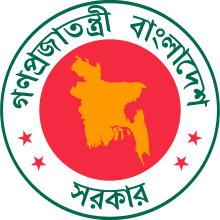Bangladesh Planning Commission
|
| |
| Agency overview | |
|---|---|
| Formed | 31 January 1972 |
| Headquarters | Dhaka |
| Agency executive |
|
Bangladesh Planning Commission[1] (denoted as PC) is a financial and public policy development institution of the Government of Bangladesh. The Planning Commission undertakes research studies and state policy development initiatives for the growth of national economy and the expansion of the public and state infrastructure of the country in tandem under the Ministry of Planning (MoP) with the Ministry of Finance (MoF).[2][3][4]
In addition the Planning Commission was to serve as the Secretariat for major economic policy questions and for initiating the appraisal of development projects and programmes by:
- National Economic Council (NEC).
- Executive Committee of the National Economic Council (ECNEC).
National Economic Council (NEC)
National Economic Council is the highest political authority for consideration of development activities reflective of long-term national policies and objectives in Bangladesh. It serves as the economic mini-cabinet, consisting of the main economic ministers of the cabinet and headed by the Prime Minister.
Generally, the ministries formulate their respective plans and programmes or projects as per objectives formulated by the NEC. It consists of all members of the Cabinet and is Prime Minitesr is the chairperson. The NEC meets as when required, and in one particular meeting the attendance requirement depends on the subjects under consideration. Planning Division is the secretariat. All NEC proposals are later provided to ECNEC to be approved.
Structure
- Prime Minister of Bangladesh (Chairperson)
- Ministers of the Council of Ministers (Member)
Supporting officials
- Cabinet Secretary
- Governor, Bangladesh Bank
- All Members, Planning Commission
- Secretary, Concerned Ministry/Division
Functions of the NEC
- To provide overall guidance at the stage of the formulation of Five Year Plans. Annual Development Programmes and Economic Policies.
- To finalize and approve plans, programmes and policies.
- To review progress of implementation of development programme.
- To take such others decisions and actions as may be considered necessary for socio- economic development.
- To appoint such committees as deemed fit to assist the NEC in the due discharge of its responsibilities.
- evaluation :impact analysis of project,programmers and plans on the people's living standard
Meetings
- Meeting of NEC is held every month and can be held earlier if required.
- Planning Division provides secretarial service to the NEC.
Executive Committee of the National Economic Council (ECNEC)
The ECNEC Wing is in charge of coordinating meetings of ECNEC and monitoring the decisions taken at the meetings. ECNEC Wing is headed by Joint Chief, who is supported by 2 Deputy Chiefs and 2 Assistant Secretaries
Structure
- Prime Minister Chairperson
- Minister, Ministry of Finance Alternate Chairman
- Minister, Ministry of Planning Member
- Minster, Ministry of Agriculture Member
- Minister, Ministry of Labour and Employment Member
- Minister, Ministry of Water Resources Member
- Minister, Ministry of Commerce Member
- Minister, Ministry of Communication. Member
- Minister, Ministry of Shipping Member
- Minister/State minister of the concerned Ministry Member
Supporting officials
- Cabinet Secretary
- Principal Secretary / Secretary, Prime Minister’s Office
- Secretary, Economic Relations Division
- Secretary, Finance Division
- Secretary, Planning Division
- Secretary, IMED
- Member, General Economics Division, Planning Commission
- Member, Programming, Planning Commission
- Secretary, Concerned Ministry/Division
Functions of the ECNEC
The primary functions of the ECNEC Wing are the following:
- to call meetings among members of NEC, ECNEC and other relevant officials
- prepare minutes of meetings, distribute them and publish them from time to time
- monitor decisions taken at the meetings
Meetings
To consider and approve yearly target of foreign aid, expansion of trade, export of manpower as well as to review the progress of the yearly targets.
- Meeting of ECNEC is held as and when required
- Planning Division provides secretarial services to the ECNEC.
See also
References
- ↑ "Ministries plan programmes to attain 17 SDG targets". The Financial Express Online Version. Retrieved 2016-10-01.
- ↑ "Planning Commission - Banglapedia". en.banglapedia.org. Retrieved 2016-10-01.
- ↑ "Ministries plan programmes to attain 17 SDG targets". The Financial Express Online Version. Retrieved 2016-10-01.
- ↑ "SDG implemetation - 'whole of society approach'". The Financial Express Online Version. Retrieved 2016-10-01.
External links
- National Economic Council in Banglapedia
- National Economic Council in Planning Commission site.
